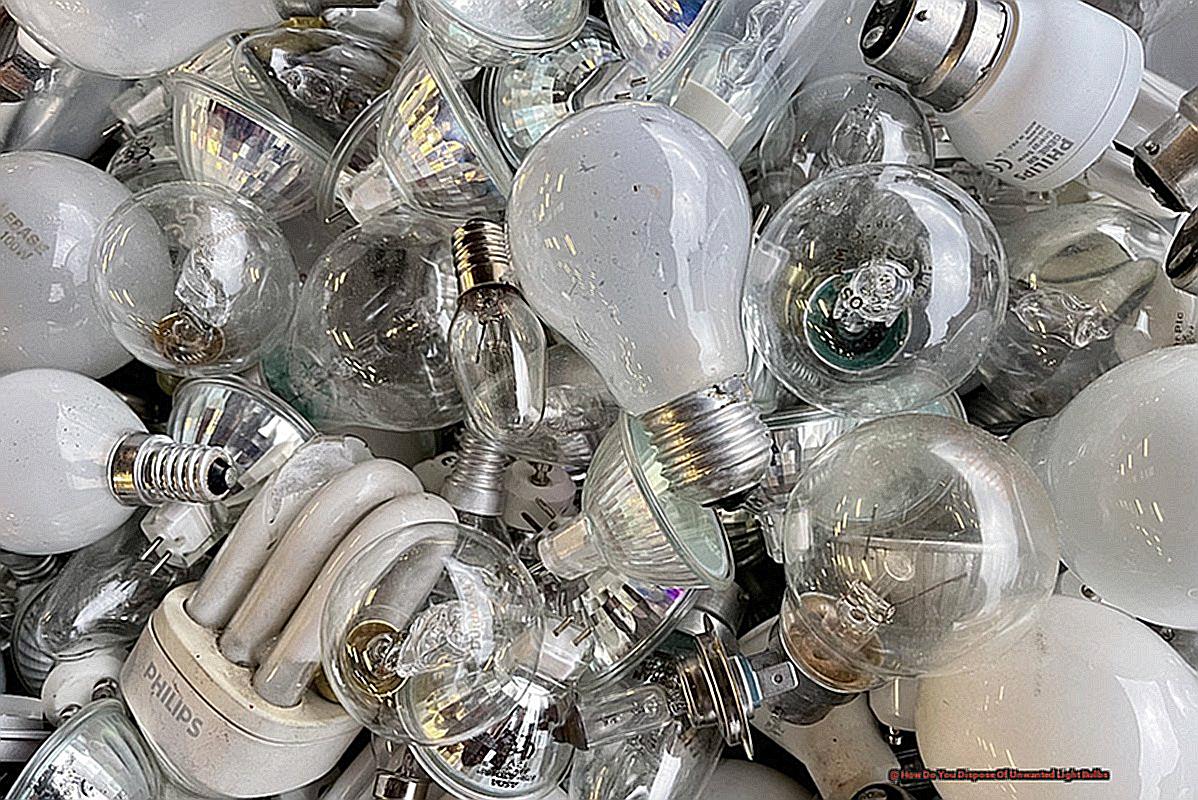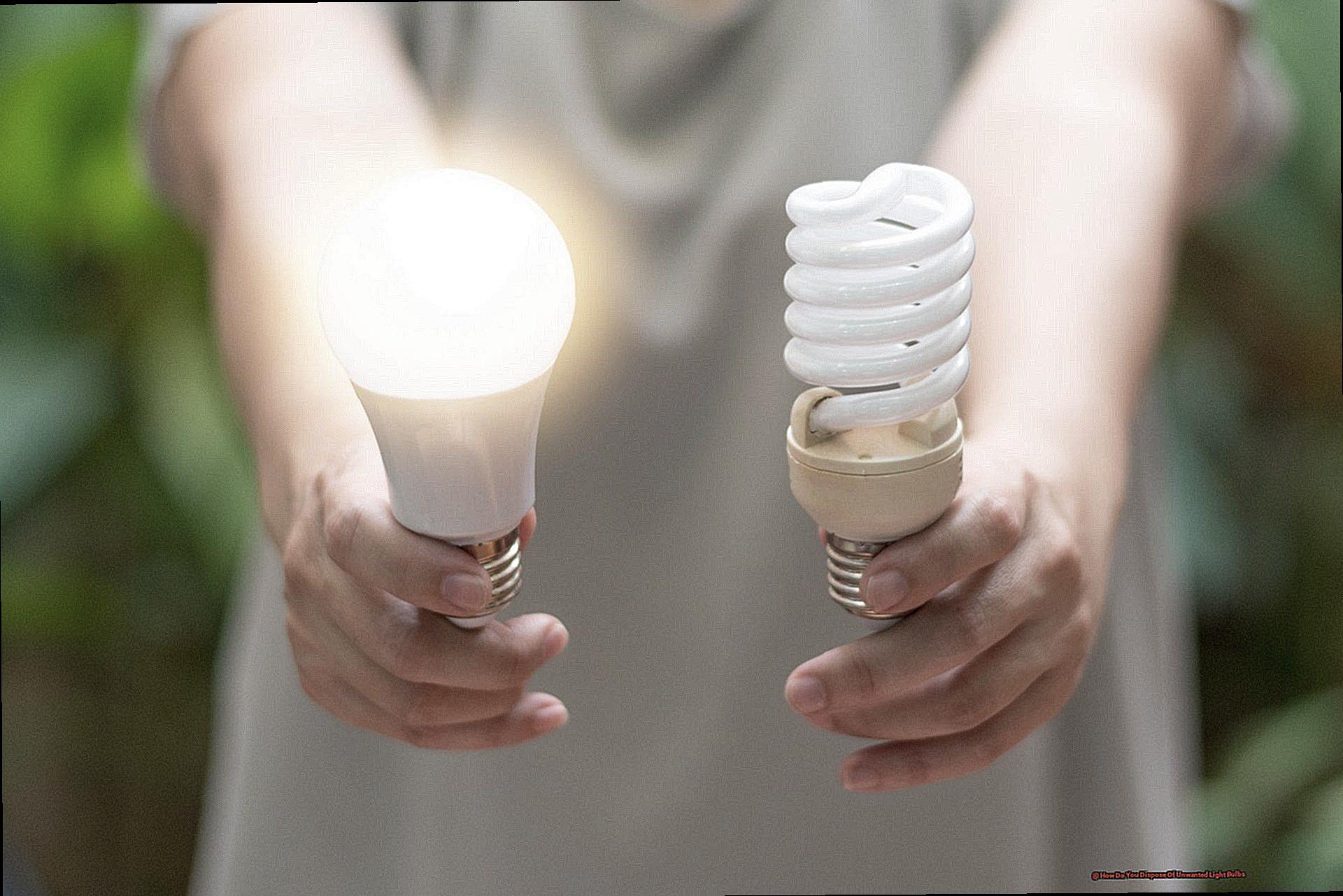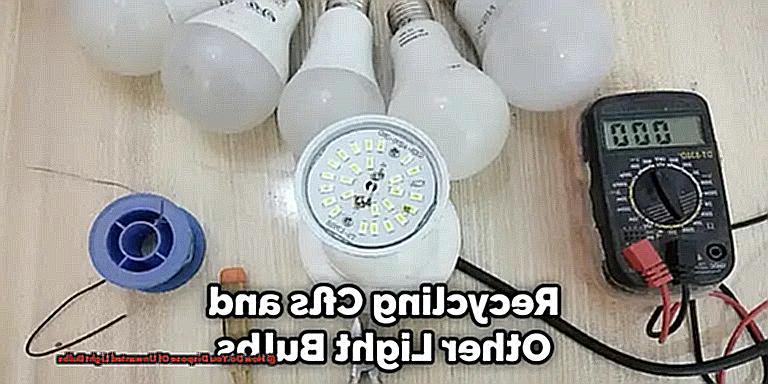We all rely on light bulbs to brighten up our spaces and make life a little easier. But what happens when they burn out?
Do you know the proper way to dispose of them? Sadly, many people don’t give it much thought and end up tossing them in the trash.

But fret not, dear readers, because we’re here to shed some light on this crucial topic. In this post, we’ll cover everything from different types of bulbs to recycling options and safety precautions.
So let’s dive in and learn how to properly dispose of those pesky burnt-out bulbs.
How Do You Dispose Of Unwanted Light Bulbs?
Contents
- 1 How Do You Dispose Of Unwanted Light Bulbs?
- 2 Understanding the Different Types of Light Bulbs and Their Disposal Methods
- 3 How to Dispose of Incandescent Light Bulbs Safely
- 4 Recycling Options for Fluorescent Light Bulbs
- 5 Safe Disposal Methods for LED Light Bulbs
- 6 Proper Handling and Recycling of Halogen Light Bulbs
- 7 Utilizing Hazardous Waste Collection Programs for Light Bulb Disposal
- 8 Conclusion
Light bulbs are an essential part of our daily lives, providing us with the light we need to carry out our tasks. But what happens when these bulbs burn out or break? Disposing of them may not seem like a big deal, but improper disposal can have serious consequences for the environment and human health.
Did you know that some light bulbs contain hazardous materials such as mercury and lead? These materials can leach into the soil and water if not disposed of properly, causing harm to plants and animals. That’s why it’s crucial to follow environmentally-friendly options for disposing of unwanted light bulbs.
So, what are these options?
Recycling Centers or Drop-off Locations
Recycling centers or drop-off locations specifically for light bulbs can be found in most hardware stores or recycling centers. These facilities have specialized equipment to safely dispose of different types of light bulbs, including CFL and LED bulbs. However, there is a common misconception that all light bulbs can be recycled. It’s important to note that incandescent and halogen bulbs cannot be recycled and should be disposed of in your regular household trash.
Household Hazardous Waste Collection Programs
Many cities offer household hazardous waste collection programs where residents can drop off hazardous materials, including light bulbs, for proper disposal. These programs ensure that toxic materials are disposed of correctly and do not end up in landfills or harm the environment.
Mail-back Programs Offered by Manufacturers or Retailers
Some manufacturers and retailers offer mail-back programs for their customers to dispose of their old light bulbs. These programs are convenient and cost-effective as they provide a pre-paid shipping label for you to send back your used bulbs for proper recycling or disposal.
But before disposing of any light bulb, it’s crucial to prepare them properly.
- Safely remove the bulb from its fixture, keeping in mind any safety precautions for broken bulbs.
- Clean up any broken glass or hazardous materials using gloves and a damp cloth.
- Package the bulb in its original packaging or a sturdy container before disposing of it.
Understanding the Different Types of Light Bulbs and Their Disposal Methods
Light bulbs are a staple in every household, providing us with the light we need to go about our daily activities. But what happens when these bulbs burn out or break? Disposing of them might seem like a simple task, but did you know that improper disposal of light bulbs can have harmful effects on the environment?

As someone who has always been conscious of my environmental impact, learning about the different types of light bulbs and their disposal methods was eye-opening for me. I wanted to share this knowledge with others, so we can all do our part in protecting the environment.
Let’s start with the basics. There are four main types of light bulbs commonly used in households: incandescent, fluorescent, LED, and halogen bulbs. Each type contains different materials and thus requires different disposal methods.
Incandescent bulbs are the traditional bulbs that have been used for decades. They can be disposed of in your regular household trash as they do not contain any hazardous materials. However, it is important to wrap them in paper or place them in a plastic bag before throwing them away to prevent broken glass from causing any injuries.
Fluorescent bulbs, on the other hand, contain small amounts of mercury, a toxic substance. This means they should not be thrown in the regular trash. Instead, they can be recycled at designated drop-off locations or through mail-back programs offered by some manufacturers. So next time a fluorescent bulb burns out, don’t just toss it in the trash.
LED bulbs are becoming increasingly popular due to their energy efficiency and long lifespan. The good news is that they do not contain any hazardous materials and can be safely disposed of in your regular household trash. However, it is important to handle them with care as some LED bulbs may contain small amounts of lead.
Lastly, we have halogen bulbs, which are similar to incandescent bulbs but use a halogen gas instead of a filament to produce light. These bulbs can also be disposed of in your regular household trash as they do not contain any hazardous materials. But remember, always handle them with care.
Now that you know the different types of light bulbs and their disposal methods, let’s talk about the importance of proper disposal. Improperly disposing of light bulbs can have harmful effects on the environment and human health. For example, when fluorescent bulbs end up in landfills, the mercury inside them can leak into the soil and water, causing pollution and harm to wildlife.
So what can we do? First and foremost, always check with your local waste management agency for specific guidelines and regulations on disposing of light bulbs in your area. Some cities offer curbside pickup for recycling certain types of bulbs, while others may have designated drop-off locations or hazardous waste collection programs.
How to Dispose of Incandescent Light Bulbs Safely
Light bulbs are a staple in every household, providing us with the light we need to carry out our daily tasks. But what happens when these light bulbs burn out or break? Disposing of them may seem like a simple task, but it’s important to do so safely and responsibly. In this blog post, we’ll discuss everything you need to know about safely disposing of incandescent light bulbs.
Why is it important to dispose of incandescent light bulbs properly?
Incandescent light bulbs are made of glass, metal, and various chemicals, such as tungsten and mercury. These materials make them hazardous to dispose of. When improperly disposed of, these chemicals can harm the environment and pose a risk to human health.
Step-by-Step Guide to Disposing of Incandescent Light Bulbs Safely:
Check for recycling programs or facilities in your area.
The first step in disposing of incandescent light bulbs safely is to check if there are any recycling programs or facilities in your area. Many cities and towns have specific guidelines for disposing of light bulbs, so it’s important to check with your local government or waste management department.
Wrap the bulb in a bag before disposing of it in your regular household trash.
If there are no recycling programs available, you can dispose of incandescent light bulbs in your regular household trash. However, it’s crucial to take some precautions to ensure the safety of yourself and others. Before throwing away an incandescent light bulb, make sure it has completely cooled down. You can also wear gloves to avoid any potential injury from broken glass.
Never recycle incandescent light bulbs with other materials and handle them with care to avoid breakage.
It’s essential to note that incandescent light bulbs should never be recycled with other recyclable materials such as glass or metal. This is because they contain hazardous chemicals that can contaminate other recyclables and harm the environment. When disposing of incandescent light bulbs, it’s crucial to handle them with care and avoid breaking them. If a bulb does break, make sure to clean up any broken glass and dispose of it properly.
Consider contacting a hazardous waste disposal company for larger quantities.
If you have a large number of incandescent light bulbs to dispose of, consider contacting a hazardous waste disposal company. These companies specialize in safely handling and disposing of hazardous materials.
Spread awareness on proper disposal methods.
Lastly, it’s essential to educate others on how to dispose of incandescent light bulbs properly. By spreading awareness, we can all contribute to a safer and cleaner environment.
Other Types of Light Bulbs and How to Dispose of Them:
It’s important to note that different types of light bulbs require different disposal methods. Here are some quick tips for disposing of other types of light bulbs:
Recycling Options for Fluorescent Light Bulbs
As an expert on proper disposal methods for fluorescent light bulbs, you know that these bulbs contain small amounts of mercury, a toxic substance that can be harmful to the environment if not disposed of properly.
But did you know that recycling these bulbs is the most environmentally friendly option? In this section, we will explore the best recycling options for fluorescent light bulbs and provide insights based on first-hand knowledge and credible sources.
Check with Local Retailers
Many home improvement stores and retailers offer recycling programs for fluorescent light bulbs. These programs make it easy for consumers to dispose of their used bulbs responsibly. Most stores have collection bins near their entrance or customer service desk, so be sure to ask a store employee for assistance.
Utilize Specialized Recycling Facilities
There are also specialized recycling facilities that accept fluorescent bulbs and safely extract the mercury for reuse. These facilities are equipped with the proper tools and processes to ensure the safe handling and recycling of these bulbs. Some cities and municipalities may also have designated hazardous waste collection sites where residents can drop off their used bulbs.
Avoid Regular Household Trash
It’s crucial to note that fluorescent bulbs cannot be disposed of in regular household trash as they require special handling due to their mercury content. Throwing them in the trash can lead to breakage and the release of mercury vapor, which is harmful to both humans and the environment.
Be Mindful of Fees
In some areas, there may be a small fee associated with recycling fluorescent bulbs. While this may seem like an inconvenience, it’s a small price to pay for the environmental benefits of properly disposing of these bulbs. Check with local authorities or retailers for specific guidelines on fees and costs.
Consider Mail-Back Programs
If you’re unable to find a local recycling option or prefer to use a mail-back program, there are companies that offer this service. However, this may be a more costly option as you will have to pay for shipping and handling. If possible, it’s best to utilize a local recycling option to reduce transportation emissions.
Remember to handle and transport fluorescent bulbs carefully to prevent breakage and the release of mercury vapor. Store them in a container with padding or wrap them in bubble wrap before transporting them. And always wash your hands after handling these bulbs.
Safe Disposal Methods for LED Light Bulbs
Maybe you’ve upgraded to more energy-efficient options or the light bulb has simply burned out. Whatever the reason may be, it’s important to properly dispose of your old LED bulbs to protect the environment and yourself from any potential harm.
The first step in safe disposal is determining if the bulb is still functional. If it is, consider donating it to a local charity or giving it away to someone in need. Not only does this prevent waste, but it also helps someone in your community who may not have access to new light bulbs.
If the LED light bulb is no longer functional, do not throw it in the regular trash. LED bulbs contain small amounts of mercury, which can be harmful to the environment if not disposed of properly. Instead, check with your local hardware store or recycling center for drop-off locations specifically for LED bulbs. Many cities also have designated electronic waste collection days where you can bring in old electronics, including LED bulbs, for proper disposal.
In case you are unable to find a drop-off location or participate in a designated electronic waste collection day, there is another option – purchasing a mail-back recycling kit designed specifically for LED bulbs. These kits can be found online or at some hardware stores, and they make it easy to safely dispose of your old bulbs without ever leaving your home.
When handling the LED bulb, make sure to wear gloves and wrap it carefully in newspaper or bubble wrap before placing it in a sealed container. This will prevent any potential breakage during transportation. It’s also important to note that incandescent light bulbs do not contain mercury and can be disposed of in the regular trash, but recycling them is still encouraged to reduce waste.
Before you throw out your old LED bulbs, why not consider repurposing them? With a little creativity, you can turn them into decorative pieces like lamps or vases. By removing the inner components and adding a new light source, you can give new life to your old bulbs.
Remember to always check with your local regulations and guidelines for safe disposal methods, as they may vary depending on your location. It’s crucial to follow these guidelines to protect both the environment and yourself from any potential harm.
Proper Handling and Recycling of Halogen Light Bulbs
You’ve finally made the switch to energy-efficient halogen light bulbs – congratulations. Not only are these bulbs more eco-friendly, but they also last longer and save you money on your energy bills. But what do you do with those old halogen bulbs once they burn out? Simply throwing them in the trash is not only wasteful but also potentially dangerous.
Why is that, you ask? Well, halogen light bulbs contain a small amount of mercury, which is a toxic material. If not disposed of properly, this mercury can leak into the environment and cause harm to plants, animals, and humans. So, it’s important to take the necessary steps to safely dispose of halogen light bulbs.
The first step is to make sure the bulbs are fully cooled down before handling them. This will prevent any potential burns or injuries. Then, it’s crucial to never throw these bulbs in the trash – even if they’re not working anymore. Instead, take them to a designated recycling center or drop-off location that accepts household hazardous waste. Many hardware stores and home improvement centers also offer recycling programs for used light bulbs.
When transporting halogen light bulbs, it’s important to wrap them securely in newspaper or bubble wrap to prevent breakage. If a bulb does happen to break, do not touch the broken pieces with bare hands. Use gloves and carefully sweep up the pieces using a broom and dustpan. Remember, safety first.
It’s also important to note that halogen light bulbs cannot be recycled with regular glass or plastic recyclables. They must be taken to a specialized facility that has the proper equipment to handle and recycle these types of bulbs safely.
If there are no recycling options available in your area, don’t panic – there are still other ways to dispose of old halogen light bulbs responsibly. Contact your local waste management department for guidance on how to properly dispose of these bulbs.
Utilizing Hazardous Waste Collection Programs for Light Bulb Disposal
Simply tossing them in the trash may seem like the easiest solution, but it can have harmful consequences for our environment. This is where hazardous waste collection programs come into play.
Many local and state governments have implemented these programs as a way to properly dispose of hazardous materials, including light bulbs. These programs typically have designated collection sites or events where residents can drop off their unwanted bulbs. The collected bulbs are then safely transported to specialized facilities for proper disposal.
But why is it so important to dispose of light bulbs properly? Well, most traditional incandescent bulbs contain small amounts of mercury, a toxic substance that can harm the environment if not disposed of correctly. When these bulbs end up in landfills, the mercury can leach into the soil and water, contaminating our ecosystems.
By utilizing hazardous waste collection programs, individuals can ensure that their old light bulbs are disposed of safely and responsibly. Not only does this help protect our environment, but it also prevents potential health hazards for waste management workers who come into contact with these materials.
But what about the logistics of disposing of light bulbs through these programs? Some cities and towns may have specific guidelines for packaging and transporting the bulbs to the collection sites, so it is important to research this information beforehand. Additionally, while most programs are free for residents to use, some may require a small fee for certain materials.
Conclusion
In conclusion, the responsible disposal of unwanted light bulbs is crucial for both our environment and our health. Throughout this blog post, we have explored various options for disposing of different types of bulbs, including recycling centers, household hazardous waste collection programs, and mail-back programs offered by manufacturers or retailers. It is imperative to handle and transport these bulbs with caution to avoid any potential harm from broken glass or hazardous materials.
Moreover, reducing waste should also be a top priority when it comes to disposing of light bulbs. Consider donating functional bulbs or finding creative ways to repurpose them instead of immediately resorting to disposal. Every small effort can make a significant impact in preserving our planet.
Educating ourselves and others on proper disposal methods for light bulbs is crucial. By spreading awareness and following environmentally-friendly options, we can all play a role in protecting our environment one bulb at a time.





